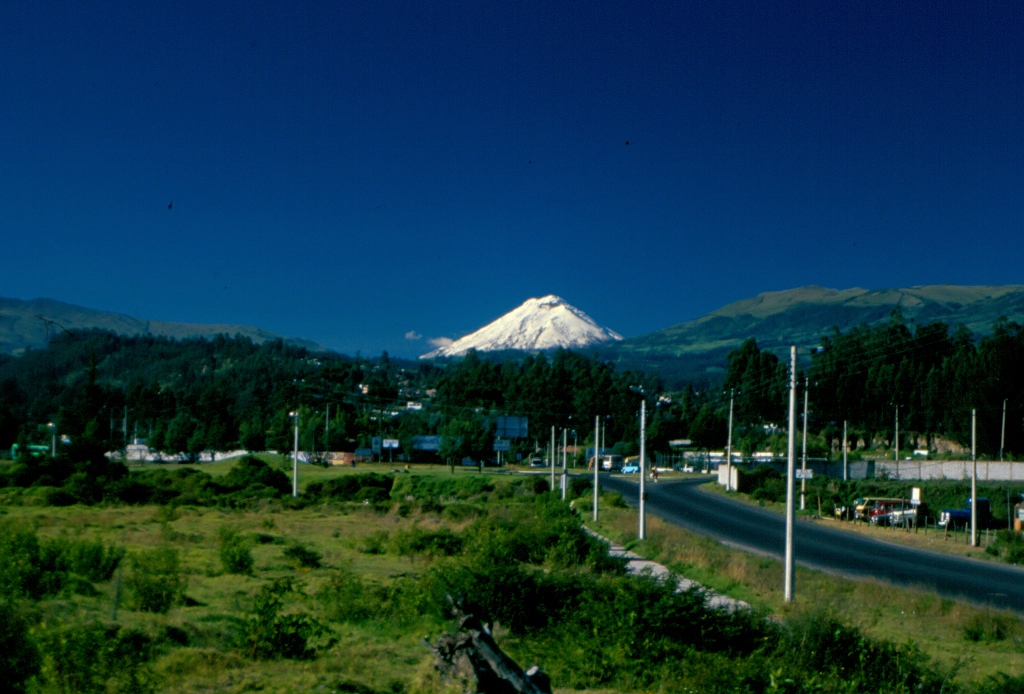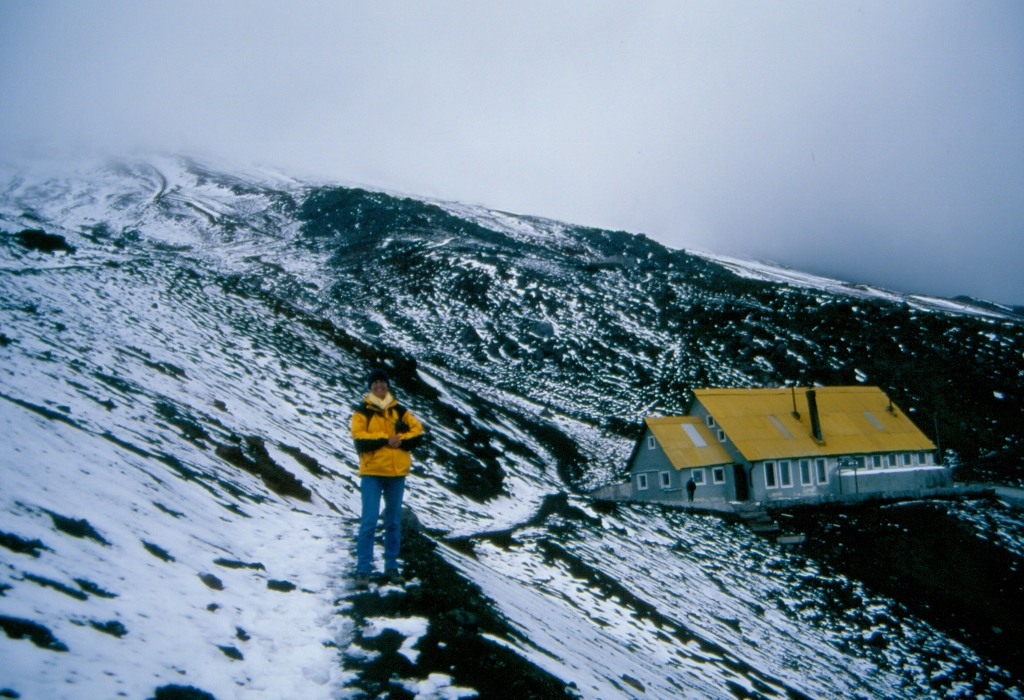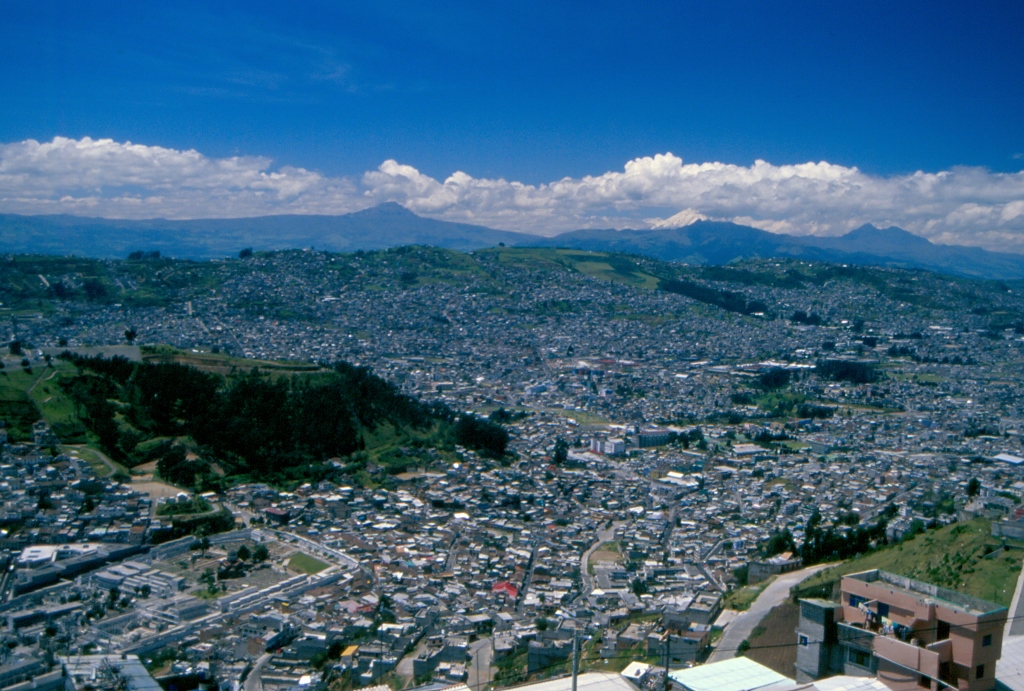Full of impressions after the Galapagos, we went back to the continental part of Ecuador and right from the airport, where we were greeting by a driver from an agency with which we had agreed about this beforehand, we headed for further visits.
The tour in fact consisted only of going to Mitad del Mundo. This is an artificially created village celebrating the equator line, i.e., 0 degrees latitude, in addition to which it is at 78 degrees 27 minutes and 8 seconds west longitude and at 2483 m above sea level. The main structure is a huge concrete tower with a museum inside which, of course, can be visited and where one can go to the top for a nice view of the surroundings. We crossed the equator also when we went to Otavalo and we took photos then as well, but that did to diminish even slightly our photo enthusiasm here. There is something funny and nice when you stand with the equator line drawn on the access path between your legs which puts one half of you in the north and the other half in the south.
We were, however, more interested in something else. Right there, quite close to the official museum there is a smaller private museum that did exactly what we wanted to see. Namely, there is a certain force going around the Earth called the Coriolis force and since it moves in different directions in the north and south, there is a story that it influences the direction of the water flow as it runs out of a toilet, for instance. According to this story, when flowing out, water starts to create a vortex which in the south moves clockwise, at equator it does not create a vortex at all and flows out straight, while in the northern hemisphere the vortex moves counter-clockwise. Well, in this private museum they show an experiment “proving” this and this is exactly what they did in front of us. They take a metal rectangular sink posted on a metal frame with legs, so that it can be moved around. Underneath it, they put a bucket in order to collect the running water into it, then they close the sink with a plug and pour water into it. When the water settles, they pull the plug out, the water starts running into the bucket and in the meantime they drop in a few small leaves that clearly show the motion of the water. And they do this in the place where the equator passes, then they move the sink a couple of meters to the north and then a couple of meters to the south. And indeed everything happened as the popular story says. Admittedly, there are explanations of serious physicists that this is unreal and untrue, especially under such un-laboratory-like conditions, which means that we were deceived. But who cares even if we were duped? We really enjoyed the experience. They even showed us, and we almost successfully tried it ourselves, how to balance an upright standing egg onto a nail head. Apparently, the gravitation, assert these local “physicists,” is weaker along the equator, so it is easier to put an egg into this awkward position.
After this, we went back to Quito and the next day I slowly parted from my friends who had flights back to their homes, while I remained in Ecuador for a couple of days more. I used this time for relaxed walks around Quito, for some shopping, as well as for a very enjoyable tour to Cotopaxi.
 Cotopaxi
Cotopaxi
Cotopaxi is a volcano not very far to the south from Quito. It is 5897 m high and this tour included a visit to a mountain refuge that is situated at 4800 m which also marks the altitude where permafrost begins. I shared the vehicle with a guide/driver and a young freshly married couple from Barcelona who had actually come to Ecuador for their honey-moon, so that their positive energy and contagious joie de vivre passed onto us.
From Quito to the south there is the so-called geographical Avenue of Volcanoes which, as its name suggests, consists of a large number of volcanoes some of which are still active, while others only show their remains. The road passing along this “avenue” is of course the Pan-American highway with its highest point in this section at 3500 m. At some point we left the highway and made a break at 3800 m being 1000 m higher than the official altitude of Quito which is the second highest capital in the world (after La Paz in Bolivia). I’m mentioning these altitudes because I live at some 300 m above sea level and from my hiking experience and stories I had heard from other hikers, human body functions significantly differently at altitudes already above 2000 m. Somebody feels this more, somebody less, but the thin air with little oxygen can also have an extremely serious impact on our organism. This particular tour was envisaged in such a way that we went to 4500 m by car and then we continued on foot, very slowly, until reaching 4800 m and the afore-mentioned mountain refuge. At these altitudes, even with no adverse circumstances in the form of snow, ice, etc., going up is quite an endeavour, especially when one is not used to such altitudes. This has NOTHING to do with general physical fitness. Unfortunately, I knew a guy who was extremely physically fit and in perfect shape, but he still passed away in the Himalayas of the consequences of altitude sickness, primarily because he was particularly sensitive to high altitudes.
Let me go back to Cotopaxi. So, this was the first time in my life that I was at this altitude and I walked very slowly, partially because I wanted to and partially because I couldn’t walk any faster. Namely, after crossing several altitude-meters, I had to stop to rest and catch my breath. It took us around one and a half hours to cover those 300 m of altitude difference, but we finally reached our goal. We recuperated a little at the refuge and drank coca tea, which I had already bought in tea bags to take back home as fun. Later, a friend “complained” that he didn’t feel anything when drinking the tea, at which I suggested that maybe he needed to chew on the tea bag in order to feel the difference. It is important to say that regardless of the fact that coca tea has some stimulative action, it is not a drug, and the effects are quite different from those of a substance derived from coca leaves. Anyway, after a short break at the refuge, we headed back to the vehicle and when we all gathered there it was time to return to Quito.
 At 4800 m a.s.l., Cotopaxi
At 4800 m a.s.l., Cotopaxi
By the way, Cotopaxi is a still active volcano, although the last major eruption was back in 1876. Talking about high summits in Ecuador, there is another interesting piece of data. Ecuador is also a home to Chimborazo, the summit of which is at 6263 m and that is the highest point on the Earth’s sphere in relation to the centre of the Earth. Let me clarify this. In relation to the sea level, the highest point is of course Mount Everest, but as the Earth is flattened on the poles and broader around its “waist,” i.e., along the equator line, and as Chimborazo is very close to the equator, this is enough to make its summit the highest in the world in a way.
When we got back to the Pan-American motorway again, we stopped at some parking lot next to a gas station because our honeymooners continued their trip going to the south of the country. They were going to Baños, so we waited for a coach going in that direction. The guide told us to stand by the edge of the motorway, look at the signs on the coaches and when we see Baños, raise our hand as a sign that the coach should stop. I was more of an observer of the whole situation than a participant, but I must admit I was impressed. Several coaches passed by heading in different directions and then one appeared driving at full speed and having a big sign in the front saying Baños. The honeymooners raised their hands, the driver stepped on the breaks as if something had run in front of him, there was squealing, the coach stopped some hundred meters farther, the honeymooners started running with their backpacks on, we were all waving and shouting good wishes one to another and then they hopped onto the coach. In other words, the coach did not stop to the side, it did not get off the motorway to the parking lot, but rather only broke in its lane, collected new passengers and continued with its journey. Well, if that’s not a good service, I don’t know what is! However, the importance of this small event is that it had far-reaching and serious consequences on my future travels. The trip to Ecuador was the first one on another continent to which I went completely alone, organizing my own stay. It was probably because of this that my transportation consisted only of taxis in towns or planes for covering larger distances. The coach my fellow travellers boarded was of the “chicken bus” type and it had genuinely never occurred to me before that I could travel in such a coach. Seeing those two, I thought to myself that I was not any greater lady than them not to take such transportation. What a turning-point this was in my life and my journeys! Ever since, local transportation would be an inevitable part of my “adventures” in different far-away countries.
Still, my Ecuador adventure was not over yet. It all started in a form of occasional dizziness when I hiked up Cotopaxi, but I still felt well then. Later, my stomach started to contract as if I had been very hungry and yet I wasn’t able to put anything into my mouth. Then my ears started to buzz. Going to a lower altitude and ending my physical activities, since I only sat in the vehicle on our way back to Quito, did not help at all. I was getting worse and worse in terms that I had less and less strength and I barely managed to cross the few meters from the vehicle into the hotel and my room. After taking a shower and resting by TV, I fell asleep already at 8.30 in the evening and slept like a log until the next morning. It was clear to me that I had an episode of altitude sickness. Not only I was at those high altitudes for the first time, it was also only two days that I came from 0 m of altitude where I spent an entire week. In other words, to say the least I was not well prepared for going some 5 km up in the air.
I spent the last full day in Ecuador at ease. First I walked a little around the new part of the city and to the park El Ejido where I sat for a little while, soaking in the sunlight. Then I went to a nearby hill where there is a museum Templo de la Patria and a monument to Mariscal Sucre, the right-hand man of Simon Bolivar, who won a decisive battle against the Spaniards at that site during the fight for independence. In addition, there is a wonderful view from there of Quito, Cotopaxi in the distance, as well as of other volcanoes. Afterwards, I walked a little bit more, visiting one of the museums, Museo Nacional del Banco Central del Ecuador.
 Quito with snow-covered Cotopaxi and other volcanoes in the distance
Quito with snow-covered Cotopaxi and other volcanoes in the distance
The next morning I had a flight that took me from Ecuador, the country which proved to be so decisive for my travels. Not only because of the experiences I gained, more as a traveller and less than a typical tourist, but primarily because a couple of months before I had started being a full-time free-lancer, which meant that I had and could have more free time and not only annual leave with a limited number of days off. This was not a particularly long journey, but it was packed with events and experiences that are still so much alive in my memory that it seems to me I have never left this beautiful country and its wonderful inhabitants.